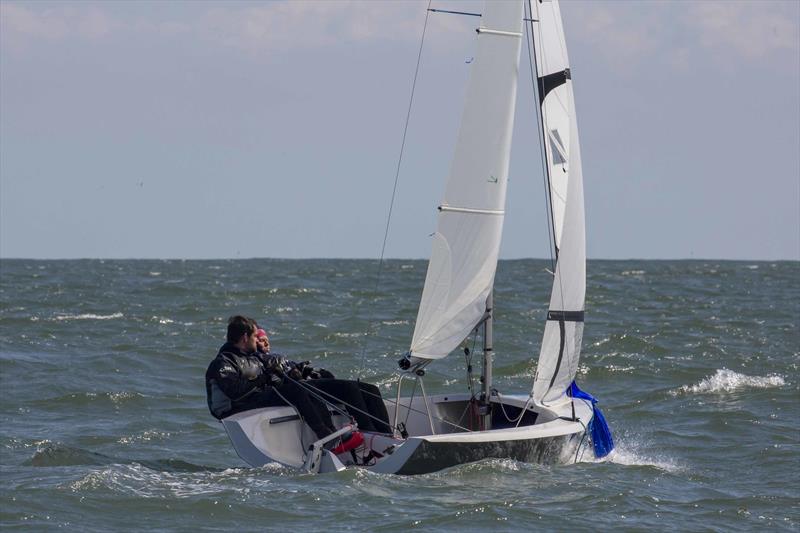
RS400 - The boat for all shapes and sizes
by Jacob Ainsworth 17 Feb 2020 14:53 GMT

RS400 sailing upwind © Tim Olin /
www.olinphoto.co.uk
Here is a settings guide from six of the top 10 crews from last year's nationals in Northern Ireland. We have focused on range of crew weights from 135kg to 170kg.
The setting guides provided demonstrates that the 400 is a very versatile boat and can be raced competitively at the top end of the fleet on the lighter end of the scale, contradicting the common misconception that the 400 is for heavier crews. For those who are on the lighter end of the scale, it is also worth reading Steve Cockerill's article on his first year in the 400, where he explains how best to depower the 400 and still be competitive at the sharp end of the fleet.
For those who would like to try before you buy, you're in luck. The association have a demo boat which will be travelling around the UK throughout the season, starting off at Notts County at the until Easter, then Carsington until May when it then goes to Warsash. To find out more about having a demo sail please email
So, having proved that the 400 can be raced at a crew weight close to a 200, for those entering the 200 nationals at Filey next year, why not continue up the coast to South Shields for the 400 nationals the following week! Find out more here.
| Helm | Boat 1 | Boat 2 | Boat 3 | Boat 4 | Boat 5 | Boat 6 |
|---|
| Crew Weight | 145KG | 148KG | 155KG | 143KG | 170KG | 135KG |
|---|
| Mast Rake | light ‑ 699cm‑ medium ‑ 696cm (1/2 down)‑ heavy ‑ 693cm (1 down) | 6m89‑99 | F0‑3 6970mm‑ F4‑5 6950mm‑ F5+ 6930mm. | Base is 6m 96cm measured from top of deck at the pintles (having set the datum on the gooseneck at 80cm. We have two/ three holes down from there. Mostly using 6m 93cm in hiking winds. | Base setting 6980mm‑ Then drop half a hole in 12‑15kts‑ then another half in 15‑20kts‑ then another half for over 20 kts. | always 6970 |
|---|
| Rig Tension | 29 on loos gauge (300lbs) unless it's light then 27 (270lbs) | 0LB | F0‑1 250lb‑ F2‑5 350‑400lb‑ F5+ 320lb. | Try to have 28 on the new loose. Can always let it go a bit to reduce the rake and power if we are on a too upright setting or increase tension if we are on too much rake (for more power). | 350lbs‑ then in very light (5kts‑) and heavy (20kts+) drop to 250lbs ish | 430lb on the superspars gauge |
|---|
| Spreader length | 41.5cm length (end to spreader metal bracket) | 5MM | 410mm (shroud to mast wall) deflection | I think currently we are on 405mm from mast track to wire (measured from the closest point of the track - not along the spreader.) | 5MM | Spreaders 420mm to side of mast |
|---|
| Deflection | 13.5cm deflection(mast to line joining spreader tips) | 5MM | 0MM | MM. | 5MM | 150mm deflection |
|---|
| Mast Foot Position | 3rd hole from back‑ never touched it really | Will need to check.. | central. | rear pin for the mast foot is third hole from most rear of the mast step. (1st hole is vang‑ second hole free - third hole is the rear pin.) | Most of the way forward‑ I think there is a hole between the King Pole and the front pin for the mast. | Middle mast foot positon |
|---|
| Mast Ram Setting | after moving rake‑ I generally wind till it's about 2 threads in tension(typically 10‑12 thread pitches exposed) | Neutral ie mast straight until spreaders | F0‑1 neutral‑ F2‑6 set to give straight mast with jib tension on. | about 6 threads showing. Never move it. On the upright setting it is generally neutral before putting the mainsail up. | Neutral in light and heavy‑ as wind picks up wind it back to 10mm in 10 ‑ 12kts then forward again as it gets windy i.e. back to Neutral. | Straight or inverted mast with white sail‑ 20mm thread on ram reduced to zero in wind. |
|---|
| Jib Car Position | all the way back always | Back all conditions | F0‑1 100% aft‑ F2‑5 one hole from the back‑ F5+ 100% aft. | back of the track. But we have added slightly longer shackles to the ratchet blocks. | All the way back‑ all the time. | All the way back and jib tack higher so we can play the sheet a lot. |
|---|
| Additional Information | | | | I pack the rudder to give me more feel. Use batten tension to open (loosen) or close the leach (tighten) | | Twist shackle on main halyard to reduce wear. Think I based on an average set up when we got boat. More bend when we use see thru main. Let battens right off‑ seems faster for us. Seems ok‑ bit scared to change! |
|---|

